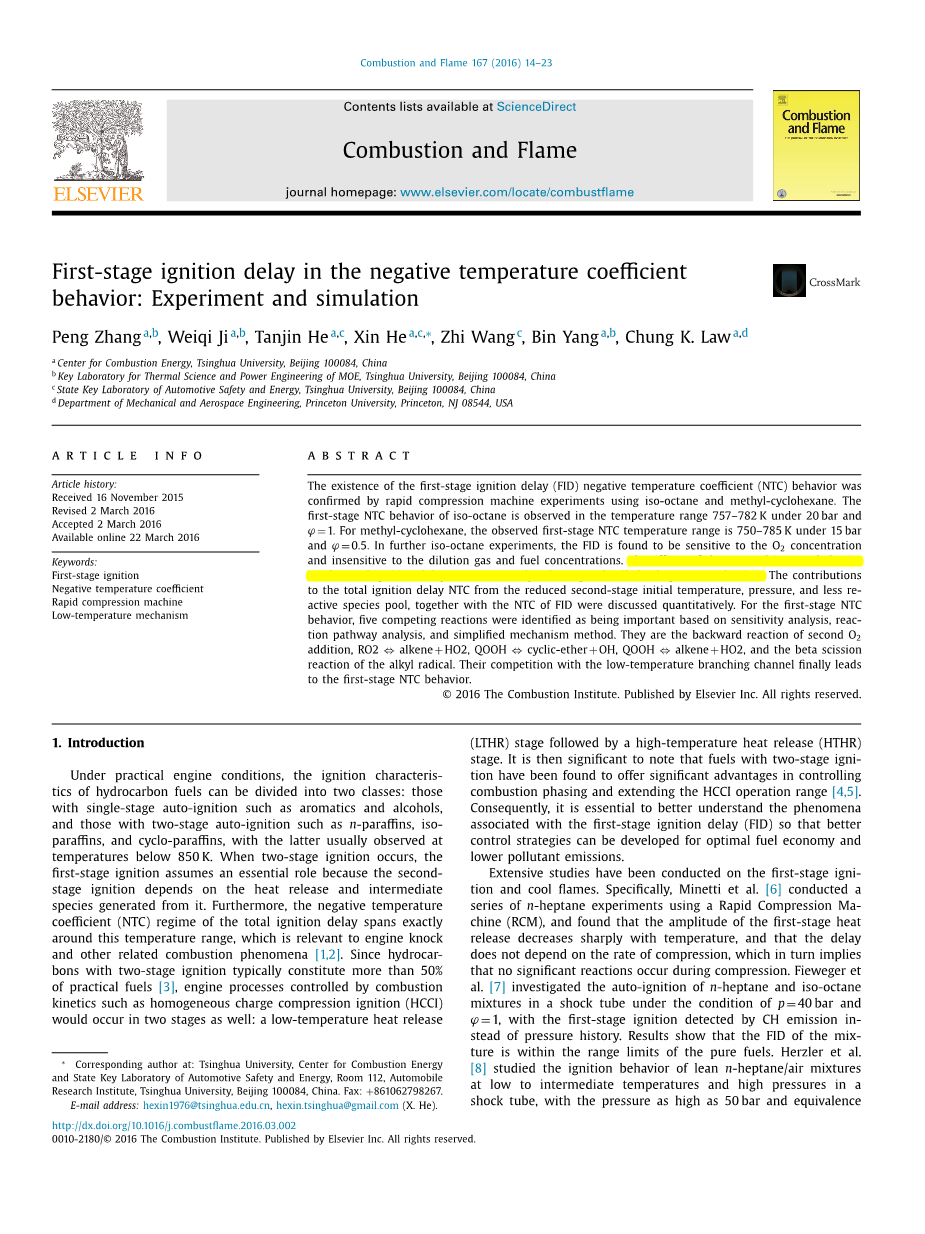|
First-stage ignition delay in the negative temperature coefficient behavior: Experiment and simulation Abstract The existence of the first-stage ignition delay (FID) negative temperature coefficient (NTC) behavior was confirmed by rapid compression machine experiments using isooctane and methyl-cyclohexane. The first-stage NTC behavior of isooctane is observed in the temperature range 757–782 K under 20 bar and ϕ =1.For methyl cyclohexane, the observed first-stage NTC temperature range is 750–785 K under 15 bar and ϕ =0.5. In further isooctane experiments, the FID is found to be sensitive to the O2 concentration and insensitive to the dilution gas and fuel concentrations. The effects of the FID and its NTC behavior on the total ignition delay NTC were analyzed using a detailed n-heptane mechanism. The contributions to the total ignition delay NTC from the reduced second-stage initial temperature, pressure, and less reactive species pool, together with the NTC of FID were discussed quantitatively. For the first-stage NTC behavior, five competing reactions were identified as being important based on sensitivity analysis, reaction pathway analysis, and simplified mechanism method. They are the backward reaction of second O2 addition, RO2 hArr; alkene HO2, QOOH hArr; cyclic ether OH, QOOH hArr; alkene HO2, and the beta scission reaction of the alkyl radical. Their competition with the low-temperature branching channel finally leads to the first-stage NTC behavior.
Under practical engine conditions, the ignition characteristics of hydrocarbon fuels can be divided into two classes: those with single-stage auto-ignition such as aromatics and alcohols, and those with two-stage auto-ignition such as nparaffins, isoparaffins, and cycloparaffins, with the latter usually observed at temperatures below 850 K. When two-stage ignition occurs, the first-stage ignition assumes an essential role because the second stage ignition depends on the heat release and intermediate species generated from it. Furthermore, the negative temperature coefficient (NTC) regime of the total ignition delay spans exactly around this temperature range, which is relevant to engine knock and other related combustion phenomena. Since hydrocarbons with two-stage ignition typically constitute more than 50% of practical fuels, engine processes controlled by combustion kinetics such as homogeneous charge compression ignition (HCCI) would occur in two stages as well: a low-temperature heat release (LTHR) stage followed by a high-temperature heat release (HTHR) stage. It is then significant to note that fuels with two-stage ignition have been found to offer significant advantages in controlling combustion phasing and extending the HCCI operation range. Consequently, it is essential to better understand the phenomena associated with the first-stage ignition delay (FID) so that better control strategies can be developed for optimal fuel economy and lower pollutant emissions. Extensive studies have been conducted on the first-stage ignition and cool flames. Specifically, Minetti et al. [6] conducted a series of n-heptane experiments using a Rapid Compression Machine (RCM), and found that the amplitude of the first-stage heat release decreases sharply with temperature, and that the delay does not depend on the rate of compression, which in turn implies that no significant reactions occur during compression. Fieweger et al. investigated the auto-ignition of n-heptane and iso-octane mixtures in a shock tube under the condition of p=40 bar and ϕ =1, with the first-stage ignition detected by CH emission instead of pressure history. Results show that the FID of the mixture is within the range limits of the pure fuels. Herzler et al. studied the ignition behavior of lean n-heptane/air mixtures at low to intermediate temperatures and high pressures in a shock tube, with the pressure as high as 50 bar and equivalence ratio varying from 0.1 to 0.4. Two-stage ignition was observed in the temperature range 720–850 K, with the FID decreasing from 2 ms to 0.1 ms with increasing temperature, and is independent of equivalence ratio. Vanhove et al. [9] studied low-temperature autoignition of five binary hydrocarbon mixtures at undiluted stoichiometric conditions using an RCM, and found that the FID decreases with increasing temperature for all the mixtures studied. Kuwahara et al. [4,10] studied the effect of fuel, O2, and N2 concentrations on FID using a detailed n-heptane mechanism generated by KUCRS (knowledge-basing utilities for complex reaction systems) , which is an automatic mechanism generation code. Under the condition of ϕ =0.5, p=1, T=759 K, the FID was found largely depending on the O2 concentration and is insensitive to the fuel and N2 concentrations. It is further noted that while most studies of the two-stage ignition and NTC behavior were conducted for homogeneous systems, recent investigations have extended the study to inhomogeneous, diffusive–convective systems, notably those of the nonpremixed counterflow. A secondary S-curve was found on the lower branch of the conventional S-curve, signifying the feasibility of NTC-controlled ignition in diffusive, nonpremixed media. The results further indicate that the FID may possess a minimum value, which is confirmed by the simulation study using the detailed mechanism. More recently, the first-stage NTC behavior of n-heptane was observed by Campbell et al. Ignition delay times of n-heptane were measured at 6.1–7.4 atm and 651–823 K using constrained reaction volume approach facilitated with staged-driver gas filling strategy, driver section extensions, driver inserts, and driver gas tailoring. The f 全文共57501字,剩余内容已隐藏,支付完成后下载完整资料
英语原文共 10 页,剩余内容已隐藏,支付完成后下载完整资料 资料编号:[12482],资料为PDF文档或Word文档,PDF文档可免费转换为Word |
正庚烷二阶段着火的模拟研究外文翻译资料
2022-05-12 20:58:13
原文和译文剩余内容已隐藏,您需要先支付 30元 才能查看原文和译文全部内容!立即支付




